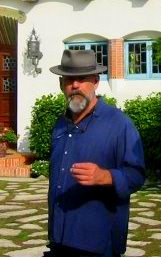
Mitchell Bishop at the Adamson House, Malibu, California. Photo: Maria Gilbert.
For the past couple of weeks I’ve been preparing a presentation about time-based art for the colloquium at the Smithsonian Institution’s Hirshhorn Museum and Sculpture Garden, “Collaborations in Conserving Time-Based Art,” which I talked about last month with Jeff Martin. I started my research for this talk with my friend Mitchell Hearns Bishop’s article, “Evolving Exemplary Pluralism: Steve McQueen’s Deadpan and Eija-Liisa Ahtila’s Anne, Aki, and God–Two Case Studies for Conserving Technology-Based Installation Art.” You can read that article on the American Institute for Conservation’s website.
Even though Mitchell worked for many years in various roles at the Getty and had both Robert Irwin and James Turrell as visiting professors in art school, I’d like to move a little bit away from concepts of contemporary art in my conversation with him. Mitchell is now the curator of historic collections at the Los Angeles County Arboretum & Botanic Garden and responsible for the historic buildings, collections, and the cultural landscape. Of course, I recognize that the L.A. Arboretum is an environmental institution, which means that its mission is more closely aligned with ecological issues rather than art history. Or is it? As much as these disciplines are different, there are similarities.
Richard McCoy: How is the Arboretum different than a fine art museum, and how has your approach shifted from that of a conservation professional to one of a curator?
Mitchell Hearns Bishop: While we do have art in the collections, the overall context is environmental so my curatorial approach needs to be aligned with that. My botanist colleagues often refer to me as the “historian,” but for me that’s problematic, as a conventional historical interpretation independent from the environmental context is meaningless.
At the Arboretum, our purpose is to promote learning and provide inspiration and enjoyment, which isn’t really that different than an art museum’s function. Take, for example, the National Gallery in Washington—the classicism and monumentality of the architecture and the quality of the collection are inspirational in a fundamental way. A lovely garden or landscape with charming old buildings provides a similar feeling. While the Arboretum has a traditional educational role, it is in the context of pleasure and inspiration. We want visitors to go away feeling good. The site itself is what I refer to as a “geography of pleasure.” It was a resort, a recreational destination one hundred forty years ago and still is today.
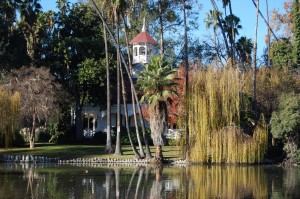
View of Baldwin Lake with Queen Anne Cottage in the background. Los Angeles County Arboretum & Botanic Garden. Photo Mitchell Bishop.
The Arboretum is unique from several standpoints. Baldwin Lake is the heart of the place. It is fed by artesian springs from the San Gabriel Mountains. It has been an oasis for wildlife for tens of thousands of years. Interestingly, it has been used by the film industry since the 30s as a location, representing everything from Myanmar to Africa, and most recently the location for Avril Lavigne’s music video for Tim Burton’s Alice in Wonderland. What’s remarkable to me about this is that people all over the world know the Arboretum’s landscape but they just aren’t aware of it. To a certain extent, the popular perception of a tropical forest comes from the Los Angeles Arboretum, which is neither tropical nor a forest.
RM: From a physical or visceral perspective, it’s fairly clear what conservators are charged with preserving when working at an art museum, but what are you presenting and preserving at the Arboretum?
MHB: Four listed historic buildings, a cultural landscape, and collections which range from society portraits to archaeological artifacts. For the most part, the preservation measures are clear cut. It gets a bit more complicated when dealing with a more-or-less intact Victorian landscape. In Europe and Australia, approaches for cultural landscape issues are highly evolved and have been codified in the Burra Charter, which was created by the Australia chapter of the International Council of Monuments and Sites (ICOMOS).
In the Eastern United States, this is dealt with more commonly, but in the West and in Southern California, less so. With multiple stakeholders and values, this gets even more complex. It has a certain significance for botanists and another for landscape architects, still another for those interested in California history, and so on. My aim is to represent all the layers of meaning and values present.
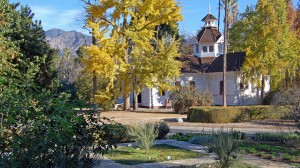
Coach Barn, architect Albert Austin Bennett (American, 1825–1890). Los Angeles County Arboretum & Botanic Garden, Arcadia, California. In the foreground, one can see the northeast corner of the Herb Garden, by landscape architect Edward Huntsman-Trout (American, 1889–1974). Photo Mitchell Bishop.
RM: Has your thinking about conservation and documentation changed much since you’ve begun working at the Arboretum? And conversely, has this affected you on a personal level?
MHB: When conserving works of art, the available evidence and the conservator’s personal experience and understanding is reflected in his or her work. This is why well-known objects are often restored and conserved multiple times–each conservation intervention corresponds to the understanding of different individuals.
Conservation of the natural world, like that of cultural property, is a work of authorship. Humans are an integral part of nature. Our actions, creations, and enormous destruction are, rationally speaking, an act of nature of no inherent qualitative value. However, since we are stuck in a dualistic mode of thinking, we try to form some sort of consensus regarding the world in which we live. In effect, what kind of world do we want to live in? What are our responsibilities toward other living species?
Biologically speaking, we are almost genetically identical to other mammals and share huge amounts of DNA with all living things on earth. We are, in fact, inseparable from other living things. In Buddhist philosophy, individual identity is regarded as a delusion similar to a dreaming state. I have come to understand that we must extend our point of view to encompass other living things.
RM: If we look to Aristotle’s Art of Poetry, he deals with this in a slightly differ way as “imitation,” “expression,” or perhaps more easily stated as an “idealized state.” Conversely, Plato was interested in an “eternal state.” Can you talk about how your work at representing and preserving landscapes deals with concepts of beauty in these terms?
MHB: An idealized state is an abstraction or essence. Plato believed that our world was a dim shadow of a greater reality. In the language of contemporary art, we could regard our world as an instantiation or a “performance.”
Cultural landscapes are the work of single individuals or entire cultures over thousands of years. In order to restore a garden or a landscape, we have to form a consensus regarding the period of interpretation of the state we want it to maintain. Obviously this is not static since gardens grow, evolve, and die—in effect, [they are] the ultimate time-based work of art.
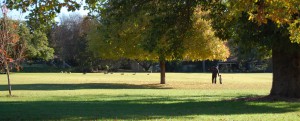
View of lawn by Bauer Fountain. Los Angeles County Arboretum & Botanic Garden. Photo Mitchell Bishop.
RM: Could you define a cultural landscape?
MHB: Certainly. The most useful definition comes from the Burra Charter, which I mentioned earlier. The Charter is relevant to all types of places of cultural significance including natural, indigenous, and historic places with cultural values and provides guidance for the conservation and management for places of cultural significance:
Place means site, area, land, landscape, building or other work, group of buildings or other works, and may include components, contents, spaces and views.
In addition, the Charter states that conservation is an integral part of the management of places of cultural significance and is an ongoing responsibility.
RM: So when we preserve a “place,” we are assigning value to it. We are saying that we want to keep this around. Can you speak to how the act of preservation assigns value to cultural landscapes?
MHB: In fact, we preserve places that have already been assigned value. The assignation of value is a prerequisite for preservation, which in turn affirms assigned value.
For example, our Coach Barn, which is on the National Register of Historic Places, is being painted. This protects the structure and preserves its intended appearance. When something is well-maintained and looks good, it is a better experience for visitors and they respond positively. It is a visceral thing. They understand that the building is valued. Value is intangible, yet its consequences are real.
RM: Could you talk about the difference between tangible and intangible cultural heritage?
MHB: Tangible cultural heritage includes works of art, buildings, gardens and landscapes, monuments and sites, and is a commodity that has intrinsic cultural and monetary value which can be controlled. Intangible cultural heritage is the expertise or knowledge required to produce these things.
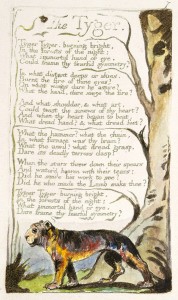
William Blake's poem, "The Tyger"
RM: We’re left with aesthetics, then, aren’t we? We’re left with the decision to chose why one landscape is beautiful, and another one ugly.
MHB: Yes. Why do we, like William Blake, find the tiger so beautiful, but find other animals hideous? The roots of our aesthetic likes and dislikes are extremely complicated. A landscape in which the mountains and a river meet the sea is very pleasing to us. Part of the reason for this is that it is a landscape that contains food resources.
But let me give you a different example: Americans love the elephant; to us it is benign, intelligent, entertaining, and a paragon of memory and familial affection. However, for African farmers, it is dangerous and destructive, and bricks of chili peppers are used as a humane way to keep it out of the crops. Apparently, elephants hate chili. Aesthetics are, after all, based on culture and personal experience.




Pingback: What’s Cookin at the Art21 Blog: A Weekly Index | Art21 Blog